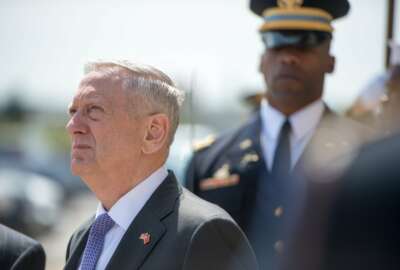

The Pentagon says its new approach to civilians is a "significant shift" that will eliminate "arbitrary caps" on how many it employs.
 Amidst a governmentwide push to reduce the total size of the civilian workforce, the Defense Department, the government’s biggest employer, is planning on moving in the opposite direction.
Amidst a governmentwide push to reduce the total size of the civilian workforce, the Defense Department, the government’s biggest employer, is planning on moving in the opposite direction.
Following eight straight years of either cutting or treading water with civilian employment figures, the department suggested that any further reductions would be counterproductive to its leaders’ goal of rebuilding military readiness. DoD said it may be time to add more nonuniformed workers to the Pentagon’s payroll.
“DoD’s civilian workforce is in the business of protecting the American way of life, not regulating or governing it,” officials wrote in a sweeping business reform plan they quietly posted online last week. “While it may be appropriate for other federal agencies to reduce their civilian workforce, for the DoD, right-sizing will necessitate targeted growth to both restore readiness and increase the lethality, capability, and capacity of our military force.”
The document, titled the “National Defense Business Operations Plan,” is an outline of dozens of management-oriented steps DoD intends to take in support of Secretary James Mattis’ National Defense Strategy. Many of the specific objectives, such as those dealing with improvements to the department’s cybersecurity, have long been underway or were previously announced.
But the plan itself describes the Pentagon’s new approach to its civilian workforce as a “significant shift.”
“Among other things, it specifically moves us away from the practice of managing to an arbitrary cap on government civilians,” according to the document, signed by John Gibson, the department’s chief management officer and its third-highest ranking official. “Such constraints or reductions generally result in the use of military manpower or contracted services to assume workload more appropriately performed by civilians. The effect is often borrowed military manpower to fill installation-level requirements, which can increase the likelihood of hollowing the force, or the use of more costly contractor work-arounds, diverting already scare resources from key readiness recovery, recapitalization, and modernization accounts.”
The plan did not identify precisely which “caps” the department is seeking to end. But previous years’ budget guidance and various congressional requirements placed constraints on DoD’s civilian workforce.
In earlier budget years, for instance, 2010 civilian workforce numbers were used as a “target” generally not to be exceeded. In 2016, Congress imposed new restrictions on the number of senior executives the Pentagon is allowed to employ.
The department is still under a 2015 legislative mandate to cut its spending on “headquarters, administrative and support” functions by $10 billion through 2019, and to reduce its headquarters spending by 25 percent before 2020.
But Defense officials also argued that the vast majority of DoD civilians do not work in headquarters organizations, and are essential to Mattis’ objective of restoring military readiness.
“The department’s lethality and readiness are not just a function of our service members,” they wrote. “DoD’s civilian workforce is essential to sustaining the viability and capabilities of the all-volunteer force – providing the critical equipment maintenance, base support, logistics and engineering expertise, family programs, and medical care that ensure our soldiers, sailors, airmen, and Marines are ready to deploy, world-wide, and answer the call of our operational commanders.”
The plan emphasizes what Defense officials said was a need to manage DoD’s personnel – including its uniformed members, civilian employees and contractors – as a “total force.”
Notably, in addition to eliminating ceilings on civilian hiring, the business reform plan calls for resurrecting the government’s process for determining whether work that is not “inherently governmental” can be done more effectively by government civilians or by contractors.
The A-76 process, in which DoD conducts competitions between contractors and civilians, has been the subject of a congressional moratorium since 2008. But the document calls for eliminating that moratorium, along with other restrictions on civilian personnel management.
The strategy said the department should “reduce the costs of doing business (associated with contracted services) at specific work units or in selected functional areas by in-sourcing to government civilian performance,” while also identifying “functions and positions that are commercial in nature that may be appropriately or efficiently delivered via private sector support.”
The plan also hints that Defense officials believe at least some work that’s currently being done by military servicemembers ought to be shifted to either civilians or contractors.
Department leaders plan to “reassess military manpower allocations for military essentiality, whether the workload requires deployments, and whether traditional military incumbency is necessary.”
The department submitted more granular details of its new approach to workforce planning to the Office of Management and Budget last September, when all federal agencies were supposed to provide the Trump administration with details on how they would reduce their numbers of civilian employees over the next four years.
But instead of a plan to reduce headcount, DoD sent OMB a “Workforce Rationalization Plan” that included more flexibility for Defense agencies and military services to shape their workforces. It did not contain cuts to the department’s total number of civilians.
None of the reform plans federal agencies sent to OMB last fall have been released to the public thus far. But the Pentagon’s version is expected to be made available “shortly,” a senior Defense official said.
According to the document the department published last week, the new workforce strategy also includes an emphasis on making maximal use of special hiring authorities Congress has already given the department. That initiative is being spearheaded under a special “plan of action” within the office of the undersecretary for personnel and readiness (P&R).
“P&R will monitor those functional workforce communities identified in this strategic plan, specifically IT, intelligence, security, and financial management, to ensure that authorities contribute to readiness and lethality expectations, through assessing time to hire and retention behavior,” officials wrote. “In addition, DoD components develop and implement human capital strategies
tailored to organizational and functional requirements. For example, the [undersecretary of Defense for research and engineering] is working on a program to develop, nurture, and access talent and expertise in a number of strategic technology domains.”
Copyright © 2024 Federal News Network. All rights reserved. This website is not intended for users located within the European Economic Area.
Jared Serbu is deputy editor of Federal News Network and reports on the Defense Department’s contracting, legislative, workforce and IT issues.
Follow @jserbuWFED


